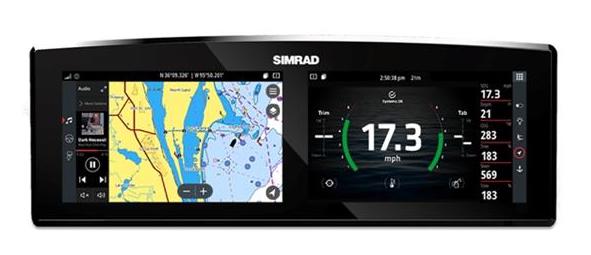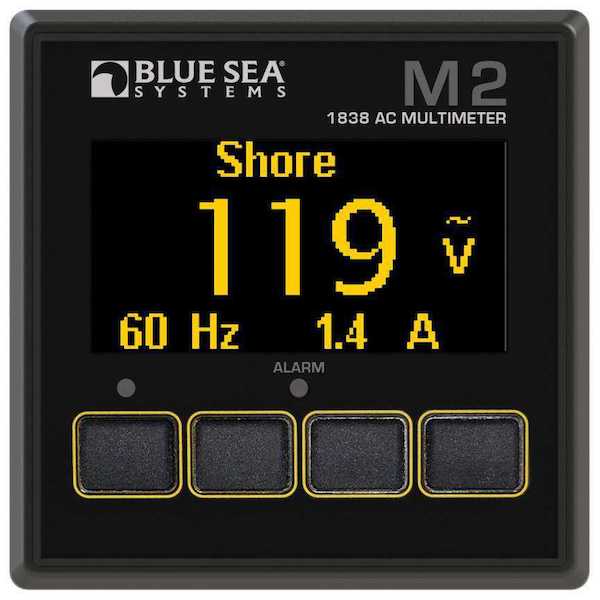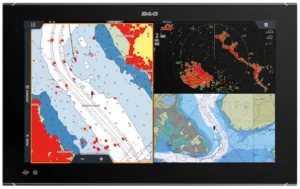When I am writing a Display Daily article, I always look for the latest and greatest news I can find. Of course what I believe is great news may not be the most interesting topic for all the readers. That is why we have different people writing articles to present to our readers the widest possible range of topics discussed by the writers.

Nevertheless, I believe that my all my colleagues follow the same idea of writing about what is the most interesting topic and perspective for them at the moment. In other words no-one wants to write about ‘the boring stuff from last year’.
Since the hot topics are somewhat limited in the display industry, I was looking for something of the beaten path. So I found this press release “Navico Shifts Electronics Paradigm with Introduction of New Display Category”, I was very excited. In case you are asking yourself, who is Navico you may be in good companionship with most other readers.
Navico is the mother company of Simrad, B&G, Lorance, and C-Map, which all focus on electronics for the marine industry. They are a competitor to Furuno, Raymarine, and other companies in this field. Unless you are into boating in a general sense, you may never have heard of these companies.
Since I enjoy sailing, this appeared to be an interesting topic to cover in an article. So what exactly is this earthshattering new display category that shifts the marine electronics paradigm? Here it is, the Navico ID (information display).
 Navico ID (information display
Navico ID (information display
So what is the the big thing about this display, you might ask? That is a really good question to ask as the description on the Novice Website is more than cryptic. Here is an excerpt of the press release, “Information displays are the realization of a long-term goal shared by both boat builders and Navico — a sleek, custom, fully upgradable, automotive-like, bonded-glass display capable of sharing information from all systems on board a boat”, as said by Leif Ottoson, CEO of Navico.
What we can gather from this statement is that the Navico ID is emulating the automotive industry by combing several display units into one bonded glass panel. If you wonder what kind of display technology is driving this paradigm changer or what resolution this display has, your guess is as good as mine, because so far they are not telling.
That’s not quite what we expect from a newly released display device. The specification includes resolution, brightness, display technology, dynamic contrast frame rate, etc. All this does not seem to play any significant role in this new device. That is the difference between the marine industry and the display industry.
The display industry is driven by new technologies and specifications, while the marine industry is driven by the visual appearance in a retail situation or at an exhibition. In addition, most electronics are ordered with a new boat and the display technology does not play any important role. The usefulness in the marine environment is measured in environmental ruggedness (water resistance), sunlight visibility combined with low light dimming at night, wide viewing angles and my personal favorite readability with polarized sunglasses (guess you never thought of that one).
There are more display aspects, but what is of most interest to the buyer is what he can view on the screen, what systems are supported, what network capabilities and what the power consumption is. The latter one is mainly of importance for sailboat that are powered by batteries at night if using just the sails.
As a consequence many device specifications do not even refer to the display technology and the most display information that is given refers to resolution and brightness. The only other display spec included is the availability of an HDMI input / output. Really not what we consider much of a display spec.
B&G Zeus3 Glass Helm 24″
For example, the B&G Zeuss 24” chart plotter has fullHD resolution and a maximum brightness of 1200 nits, qualifying it as a serious outdoor display and, yes, it is most likely a LCD. Other than that, there is a whole bunch of interfaces and network connectivity that allow the display to work together with a wide range of sensors and devices from radar and forward-looking sonar to GPS, windspeed, depth sounders, etc. This 24” monitor retails for around $11,000 in case you wondered.
Well niche markets do allow for some special pricing, but for the display industry professional this is somewhat surprising when a 55” 4K UHD Smart TV retails for under $500.
 Blue Sea Systems OLED Display
Blue Sea Systems OLED Display
Looking at the marine electronics industry through the glasses of a display guy, I wondered what is the most advanced display I can buy for a boat. Yes, I did find a company Blue Sea Systems that actually sells display units based on OLED technology. I have to admit that the display units are relatively simple system monitors and the they come only in a one color flavor, but at least they are OLED.
All in all, the marine industry seems to be a lost cause for display technology innovations coming to the market. However, I believe that there is a lesson to be learned form this, display technology and performance can only be judged through the application specific requirements. What is important for a TV maybe of no consequence in the marine environment and vice versa. When we judge the performance of a display device we should always ask ourselves what the user of such a system really needs in the specific application.
This is a really great tie in with the other topic that is dear to my heart AR / VR. We have to look what the user will need and not what we can deliver, if the display doesn’t fulfill the application requirements it will go nowhere fast. (NH)

